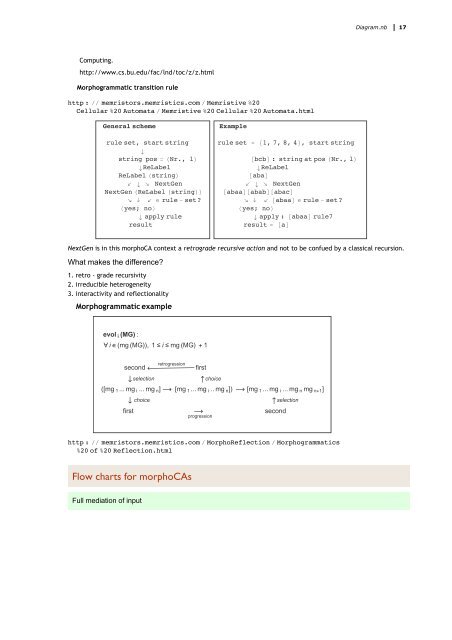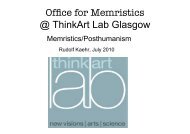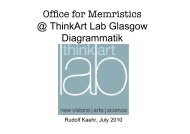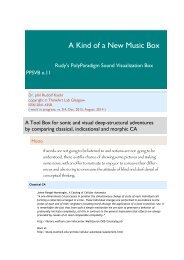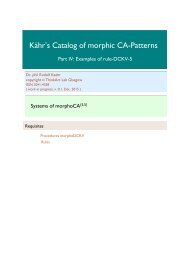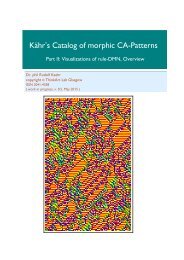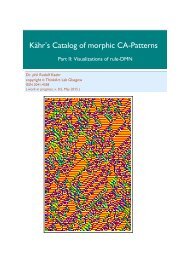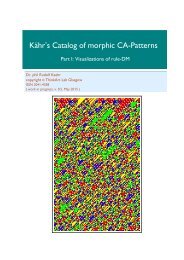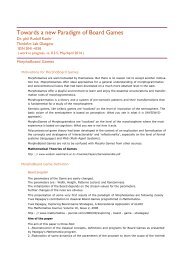Metaphors of Dissemination and Interaction of morphoCAs
Meta-theoretical considerations about the behavior of morphic cellular automata are sketched. Different types of flow diagrams for morphoCAs are distinguished: 1. mono-contextural, 2. interactional/transactional and 3. mediational poly-contextural types. Those thematizations are offering a better understanding of the nature of morphic cellular automata.
Meta-theoretical considerations about the behavior of morphic cellular automata are sketched. Different types of flow diagrams for morphoCAs are distinguished: 1. mono-contextural, 2. interactional/transactional and 3. mediational poly-contextural types. Those thematizations are offering a better understanding of the nature of morphic cellular automata.
You also want an ePaper? Increase the reach of your titles
YUMPU automatically turns print PDFs into web optimized ePapers that Google loves.
“CA are a parallel rigid model. Its sequential restriction is the Turing Machine (TM). The configuration <strong>of</strong> CA<br />
is a (possibly multi-dimensional) grid with a fixed (independent <strong>of</strong> the grid size) number <strong>of</strong> states to label<br />
the events. The states include, among other values, pointers to the grid neighbors. At each step <strong>of</strong> the<br />
Diagram.nb 17<br />
computation, the state <strong>of</strong> each cell can change as prescribed by a transition function <strong>of</strong> the previous states<br />
<strong>of</strong> the cell <strong>and</strong> its pointed-to neighbors. The initial state <strong>of</strong> the cells is the input for the CA. All subsequent<br />
states are determined by the transition function (also called program)." Leonid A. Levin. Fundamentals <strong>of</strong><br />
Computing.<br />
http://www.cs.bu.edu/fac/lnd/toc/z/z.html<br />
Morphogrammatic transition rule<br />
http : // memristors.memristics.com / Memristive %20<br />
Cellular %20 Automata / Memristive %20 Cellular %20 Automata.html<br />
General scheme<br />
rule set, start string<br />
string pos = (Nr., l)<br />
ReLabel<br />
ReLabel (string)<br />
↙ ↘ NextGen<br />
NextGen (ReLabel (string))<br />
↘ ↓ ↙ ∈ rule - set?<br />
〈yes; no〉<br />
apply rule<br />
result<br />
Example<br />
rule set = {1, 7, 8, 4}, start string<br />
[bcb] : string at pos (Nr., l)<br />
ReLabel<br />
[aba]<br />
↙ ↘ NextGen<br />
[abaa][abab][abac]<br />
↘ ↓ ↙ [abaa] ∈ rule - set?<br />
〈yes; no〉<br />
apply : [abaa] rule7<br />
result = [a]<br />
NextGen is in this morphoCA context a retrograde recursive action <strong>and</strong> not to be confued by a classical recursion.<br />
What makes the difference?<br />
1. retro - grade recursivity<br />
2. irreducible heterogeneity<br />
3. interactivity <strong>and</strong> reflectionality<br />
Morphogrammatic example<br />
evol i (MG) :<br />
∀ i ∈ (mg (MG)), 1 ≤ i ≤ mg (MG) + 1<br />
second<br />
selection<br />
retrogression<br />
first<br />
choice<br />
([mg 1 ... mg i ... mg n ] ⟶ [mg 1 ... mg i .. mg n ]) ⟶ [mg 1 ... mg i ... mg n mg n+1 ]<br />
first<br />
choice<br />
⟶<br />
progression<br />
second<br />
selection<br />
http : // memristors.memristics.com / MorphoReflection / Morphogrammatics<br />
%20 <strong>of</strong> %20 Reflection.html<br />
Flow charts for <strong>morphoCAs</strong><br />
Full mediation <strong>of</strong> input


